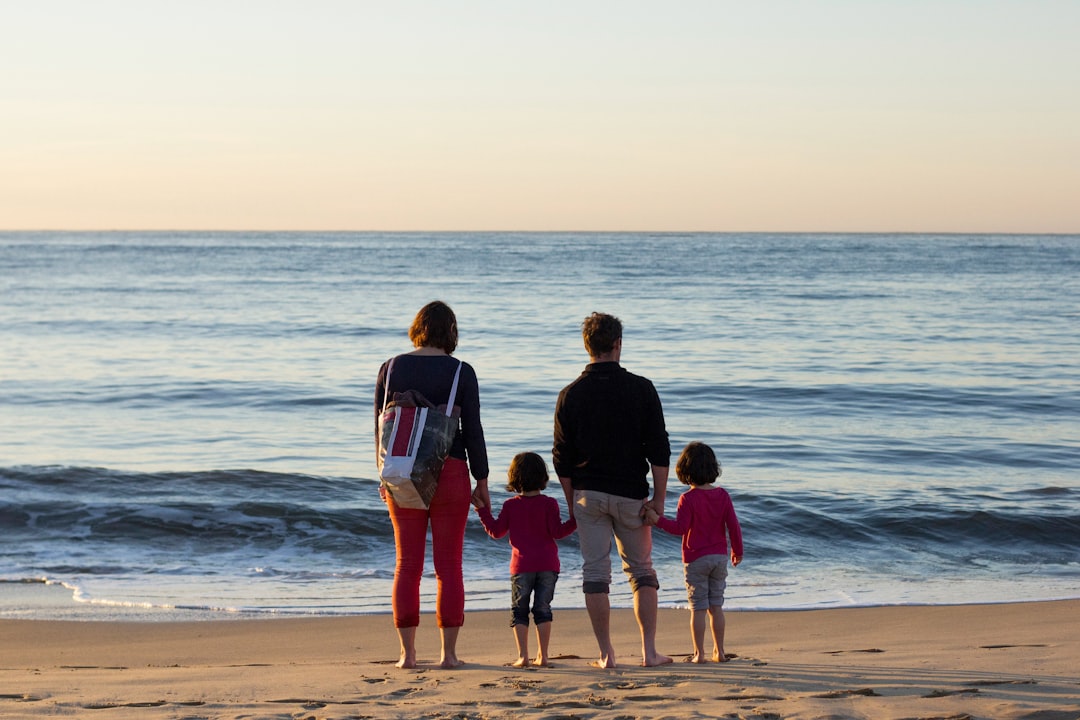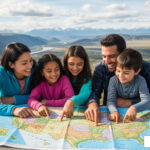Family Travel Tips: 7 Ultimate Stress-Free
Why Family Travel Creates Lifelong Memories
Family travel tips can transform stressful vacation planning into exciting adventures that bring families closer. While 85% of parents say family vacations are important for their children’s development, many feel overwhelmed by the planning process. With the right approach, family travel becomes less stressful and more rewarding.
Family travel is about creating shared experiences that strengthen bonds and build confidence. Research shows that children who travel frequently become more adaptable and develop a global perspective. The key is knowing which strategies work when juggling different ages and budgets. From involving kids in planning to mastering airport security, the right preparation makes all the difference.
Here are the essential strategies every parent needs:
- Plan together: Involve children in choosing destinations and activities.
- Pack smart: Bring essentials in carry-on and pack light with versatile clothing.
- Keep kids entertained: Use novel toys, audiobooks, and screen time for travel days.
- Prioritize safety: Get travel insurance and pack a first-aid kit.
- Travel on a budget: Consider shoulder season trips and free activities.
- Stay flexible: Under-plan schedules and prepare for meltdowns.
- Maintain routines: Stick to familiar sleep schedules and snacks.

Quick family travel tips definitions:
Tip 1: Plan Together, Travel Happier

One of the best family travel tips is to make planning a family affair. Involving everyone builds excitement and turns kids into travel cheerleaders. Most families plan vacations 3-6 months ahead for better deals and availability. Use this time to get your kids involved. Give them a map, let them research activities, and help create the packing list. This transforms potential anxiety into anticipation.
Choose destinations that welcome families, as about 70% of parents prioritize kid-friendly activities. Europe shines in spring with cooler temperatures and fewer crowds. Italy, for example, is known for its welcoming attitude toward children. For spring break, consider places with mild weather like Crete or Dublin, which combine history with engaging museums.
Accommodation matters. While US hotels often have family-friendly rooms, European hotels can be smaller. It’s wise to email international hotels directly to confirm they can accommodate your family. Consider apartments over hotels for more space and a kitchenette, which is a game-changer for families with picky eaters or dietary needs. Preparing some meals can save both money and meltdowns.
Finally, set travel goals together. Decide if you’re seeking adventure, city excitement, or beach relaxation. When everyone’s voice is heard, you create a trip that reflects your family’s dreams and builds lasting memories.
Tip 2: Pack Smart, Not Heavy
Efficient packing is one of those family travel tips that can make or break a vacation. The secret is bringing the right things, not everything. The golden rule is to pack smart, not heavy. Many experienced families use a “one backpack per person” approach. As children get older, they can carry their own packs.
Packing cubes are game-changers for organization. Give each family member a cube for their clothes to keep suitcases tidy. Rolling clothes instead of folding them also saves a surprising amount of space. When selecting what to bring, think versatility and layering. Choose lightweight, quick-drying items that can be mixed and matched. You can always buy basics at your destination.
Essential Carry-On Packing
Your carry-on is your family’s survival kit. It should contain everything you can’t afford to lose or need immediately.
- A full change of clothes for everyone is crucial for handling spills or accidents.
- Keep all necessary medications in their original containers to avoid issues with security. Checked baggage can get delayed, so don’t risk missing doses.
- Pack a comprehensive first-aid kit with a thermometer, pain relievers, Band-Aids, antiseptic wipes, and allergy medications.
- Essential documents like passports and boarding passes should be in your carry-on, with digital copies on your phone.
- Pack plenty of non-liquid snacks to prevent meltdowns. For babies, bring enough formula or supplies for at least 24 hours.
- Novel entertainment items like new small toys or sticker books keep kids engaged longer than familiar items.
- Don’t forget wipes and enough diapers for at least two days. Carry-on liquids must follow current security guidelines.
Gear That Makes a Difference
The right gear transforms family travel. Lightweight strollers are lifesavers in busy airports and tourist spots. A money-saving tip: you can gate-check strollers and car seats for free. If you have a travel system, bring it to transport gear through the airport.
Inflatable booster seats provide safety for older toddlers without the bulk. Baby carriers are lightweight, flexible, and keep your hands free for luggage and other children. For maintaining routines, portable blackout blinds can be invaluable, helping kids sleep better in unfamiliar, bright hotel rooms.
Tip 3: Master the Journey, Not Just the Destination

For successful family travel, the journey matters as much as the destination. Keeping everyone happy during a long flight or car ride is key. Don’t be afraid to relax screen time rules; downloaded movies and apps can be a saving grace. To make it more effective, some parents limit screen time before the trip.
Creative Entertainment Family Travel Tips
Novelty is your secret weapon. Surprise kids with sticker books, audiobooks, or small new toys. One parent packs balloons to blow up at an empty airport gate, letting kids burn off energy before boarding. Classic games like “I Spy” require no equipment, and travel journals or disposable cameras can turn older kids into engaged observers. A special “Mary Poppins bag” filled with normally-forbidden treats and toys can also work wonders. For road trips, lap desks provide a stable surface for drawing or playing.
Managing Schedules and Routines
One of the most crucial family travel tips is protecting your child’s routine. A disrupted schedule can lead to a difficult mood, so try to stick to sleep schedules as much as possible. Adapt naps to the car seat or carrier if needed.
Respect jet lag by building in a “cushion day” to decompress after arrival. Get plenty of natural light on your first day and avoid ambitious activities. Feeding babies during takeoff and landing is a classic tip that helps clear their ears and reduce discomfort from pressure changes. Finally, pack familiar snacks. They provide comfort in new environments and prevent meltdowns when local cuisine doesn’t appeal to picky eaters.
For more inspiration on keeping travel within the country manageable, explore our comprehensive resources on U.S. Travel. Mastering the journey is about preparation, flexibility, and building memories together.
Tip 4: The Ultimate Guide to Family Travel Tips for Safety and Health
Among all family travel tips, keeping your loved ones safe and healthy is paramount. This peace of mind begins with preparation long before you travel.
Travel insurance is essential for families. It protects you from financial loss and stress. For an overview of how it works, see Travel insurance. Key coverages include:
- Trip cancellation and interruption: Protects non-refundable deposits if you have to cancel due to illness or emergency.
- Emergency medical insurance: Critical for international travel. Many annual policies have limits on trip duration, so check if you need a long-stay policy for extended adventures.
- Baggage insurance: Helps replace essential items if your luggage is lost or delayed.
Always be honest about pre-existing medical conditions when purchasing a policy. Also, have an emergency plan: keep digital copies of important documents (passports, visas, insurance) and know how to find local medical care.
Essential Health and Safety Family Travel Tips
- Schedule a pre-trip doctor visit to ensure everyone is healthy enough to travel and to get any required vaccinations or prescriptions. Check destination-specific guidance at CDC Travelers’ Health.
- Practice food and water safety. Cooking some of your own meals gives you control over ingredients. A water filter bottle can be useful, and it’s often wise to ask for drinks with “no ice” in certain regions.
- Use sun protection. Pack high-SPF sunscreen, hats, and protective clothing, as sun exposure can be intense, even on cloudy days.
- Child-proof accommodations. A roll of painter’s tape can cover outlets and secure cabinets. Inflatable bed bumpers can prevent falls from unfamiliar beds.
- Use assistance programs if needed. The TSA Cares line offers help through security, and the Hidden Disabilities Sunflower Program discreetly signals hidden disabilities to airport staff worldwide.
Building a “Just-in-Case” Kit
Your first-aid kit should be comprehensive. Include a thermometer, age-appropriate pain relievers, allergy medications, antiseptic wipes, and motion sickness remedies. Store digital copies of all critical documents in a secure cloud service for backup access. A little extra planning provides the confidence to relax and enjoy your trip.
Tip 5: Travel on a Budget Without Sacrificing Fun
You don’t need to sacrifice fun to save money. While the average family spends $1,200 on a week-long vacation, smart family travel tips help you create memories without emptying your wallet.
Traveling in the shoulder season is a top money-saving strategy. Spring in Europe, for instance, offers fewer crowds, cooler weather, and lower prices than peak summer.
When it comes to affordable travel ideas, think beyond hotels. Home exchanges, apartment rentals, or house-sitting can cut accommodation costs dramatically and provide a kitchen for preparing meals. For the truly adventurous, van life or working for accommodation through work exchange platforms can provide incredible cultural experiences while saving on lodging.
Finding flight deals requires flexibility. Use flight comparison tools to check prices across different dates and destinations. Being open to alternative airports and using ground transport for shorter distances can also lead to significant savings.
Eating local versus tourist traps is better for your budget and offers a more authentic experience. Local cuisine costs less than Western food in most destinations. Packing your own snacks and reusable water bottles also saves a surprising amount of money and reduces waste. A water filter bottle lets you safely drink tap water anywhere.
Seeking out free activities often leads to the best memories. City parks, playgrounds, free museum days, local markets, beaches, and nature trails cost nothing but create priceless moments. Expensive doesn’t always mean better; some of the most treasured memories come from simple picnics in a beautiful park.
Tip 6: Accept Flexibility and Manage Meltdowns
When traveling with kids, flexibility is your superpower. This might be the most important of all family travel tips, as it turns potential disasters into memorable adventures. The “under-plan” approach gives your family breathing room. As family travel author Candyce H. Stapen says, “It’s not how much of a destination you see, but how much you and your kids enjoy the sites together.”
Balance is everything. Some of your most treasured memories might happen at a spontaneous playground stop. Building downtime into your schedule is essential. Kids need time to decompress, so don’t overschedule. This might mean an afternoon by the hotel pool or a lazy morning in your rental. Plan activities for times when kids have the most energy, not late in the day when they’re already tired.
Meltdowns will happen. The difference is how you handle them. Your calm is contagious. When you stay composed, you model how to handle stress. Distraction techniques work wonders; a new toy, puffy stickers, or your phone’s camera can shift their focus. Always acknowledge their feelings first (“I see you’re frustrated”) before redirecting them.
Sometimes the best solution is simply taking a break. That stop at a random playground isn’t lost time; it’s meltdown prevention. Managing realistic expectations is liberating. Lower your expectations for what you can accomplish in a day. Focus on one main activity and enjoy it rather than rushing through several. Your kids will remember the shared joy more than the number of sights you saw.
For more ideas on maintaining your well-being while traveling, explore our Wellness Retreats guides for inspiration.
Tip 7: Your Questions Answered: Navigating Common Travel Problems
These family travel tips address the most common travel questions we receive, combining practical advice with real-world experience.
What are the best family-friendly destinations for a spring break getaway?
Spring break can be enjoyed without crowds and high prices. Consider destinations with mild weather and fewer crowds.
- U.S. National Parks: The Southwest (Zion, Arches, Grand Canyon) is great before the summer heat. They offer hiking, wildlife viewing, and educational programs.
- Coastal towns in Southern Europe: Places like Crete or coastal Italy and Spain offer a wonderful blend of culture, relaxation, and a welcoming attitude toward children.
- Family-friendly resorts: For all-inclusive convenience, Caribbean resorts designed for families feature kid’s clubs and built-in entertainment.
- Unique adventures: A safari in South Africa can be an unforgettable multigenerational experience. For more ideas, see our Tropical Vacations guides.
How can I make travel less stressful with a toddler?
Traveling with toddlers is about working with their needs. Maintain familiar routines for sleeping and eating as much as possible. Pack comfort items, favorite snacks, and a few new toys for distraction. A baby carrier is invaluable for navigating busy areas. Plan for one major activity per day to avoid overwhelming them. Book direct flights when possible and consider accommodations with separate sleeping areas for everyone’s comfort.
What are the most essential items to pack in a carry-on for a family trip?
Your carry-on is your emergency kit. Pack these essentials:
- A complete change of clothes for everyone.
- All necessary medications in their original containers, plus a basic first-aid kit.
- Essential documents: Passports, boarding passes, and accommodation confirmations.
- Technology: A portable power bank is a must for keeping entertainment devices charged.
- Strategic snacks and supplies: Pack high-value snacks your kids love. For babies, bring enough diapers and formula for at least 24 hours.
- A small, new toy for its powerful distraction ability, plus wipes for quick clean-ups.
Conclusion
Starting on family adventures is truly an investment in shared experiences, cultural understanding, and lifelong memories. These family travel tips we’ve shared – from planning together and packing smart to mastering the journey and embracing flexibility – can transform what might feel like overwhelming logistics into joyous exploration.
The numbers speak volumes about the value families place on travel. With the global family tourism market projected to reach USD 3,151.8 billion by 2032, it’s clear that families worldwide recognize what research confirms: family vacations are important for children’s development. These journeys foster adaptability, reduce judgment, and develop that invaluable global perspective our children will carry throughout their lives.
Successful family travel isn’t about checking off every tourist attraction or maintaining perfect schedules. It’s about those unexpected moments – the balloon games in airport waiting areas, the local market findies, the quiet hotel room conversations after a day of adventure. These are the memories that stick.
The most important family travel tip of all? Start somewhere. Whether it’s a weekend road trip to a nearby national park or a spring break adventure in Italy, each journey builds your family’s confidence and travel skills. Every trip teaches you something new about what works for your unique crew.
At GoTravelHunt, we understand that planning family travel can feel daunting. That’s why we’re dedicated to making these unforgettable journeys simple and stress-free, ensuring your focus remains on creating those precious moments rather than worrying about logistics.
Your next family adventure is waiting. The planning doesn’t have to be perfect – just get started, stay flexible, and remember that the best family trips are measured not by how many places you see, but by how much joy you share along the way.
Ready to plan your next family adventure? Explore our Best Vacation Spots guides for inspiration.












